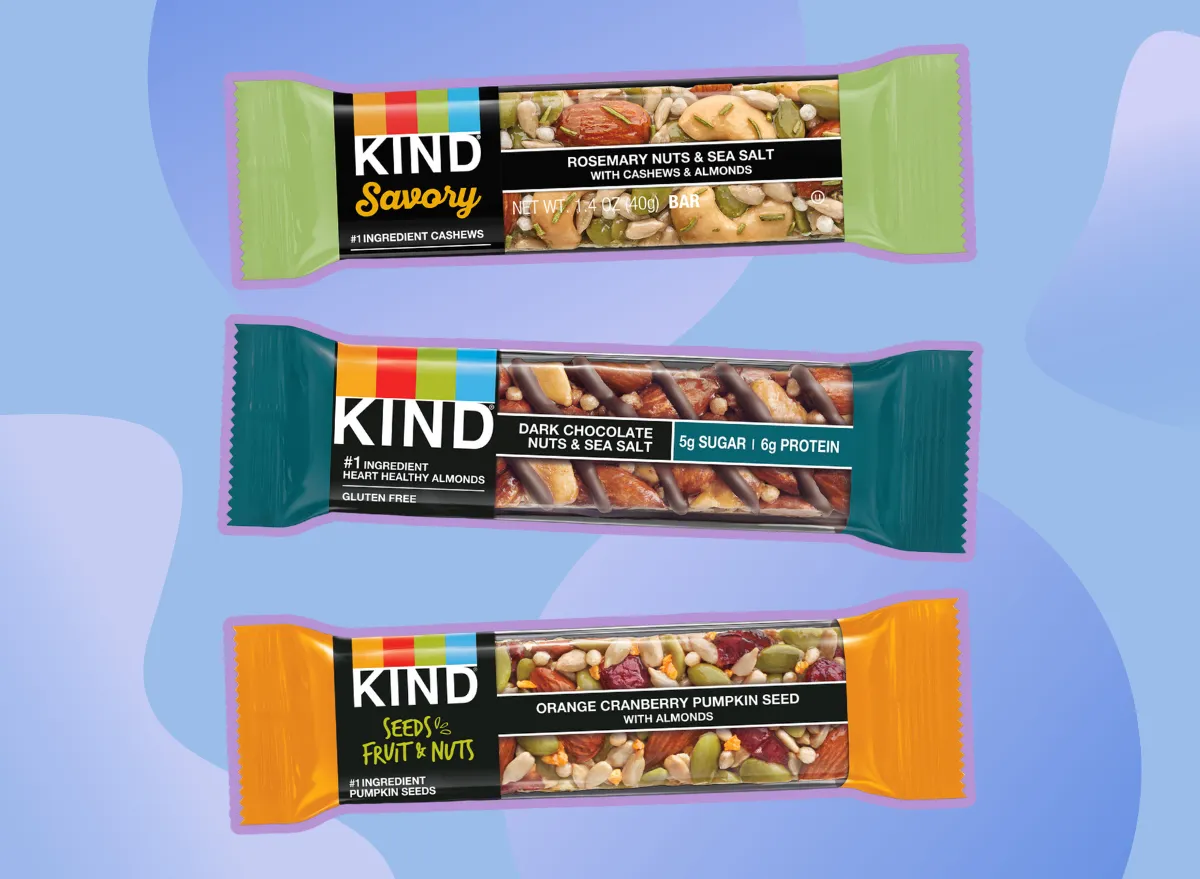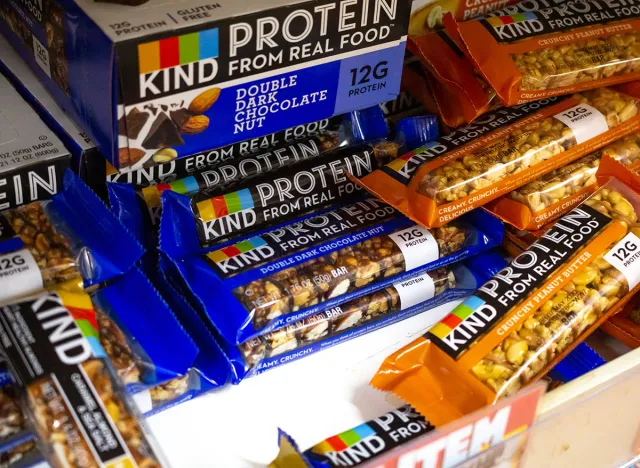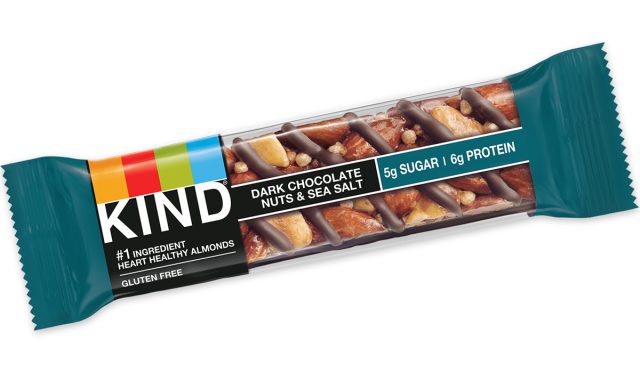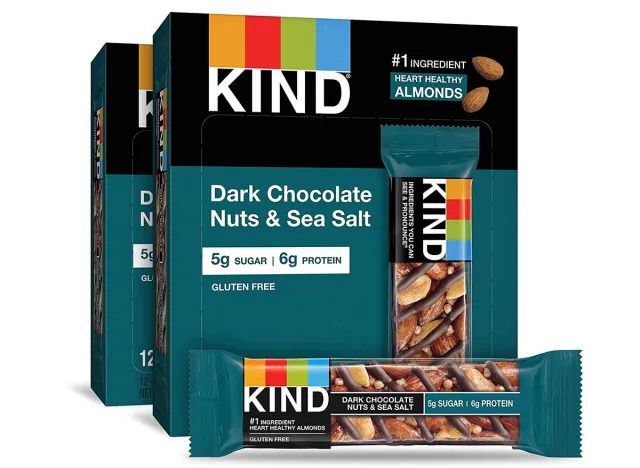Are KIND Bars Healthy? We Asked a Dietitian

Finding quick, healthy snack options can be challenging in a convenience-driven world. This frustration led Daniel Lubetzky to found KIND in 2004. KIND bars aim to fill the gap between nutrition and flavor, providing snacks made with ingredients that are easy to recognize, pronounce, and enjoy.
By avoiding high fructose corn syrup, artificial sweeteners, and sugar alcohols, KIND commits to using minimal sugar and instead focuses on wholesome ingredients like nuts, whole grains, and fruits. But are the bars really healthy? This article explores the nutritional profile of KIND bars and potential health benefits and drawbacks to help you decide whether to include them in your snack rotation.
Read on, and for more, don't miss The 16 Healthiest Low-Sugar Protein Bars.
What Are KIND Bars?

KIND was founded in 2004 by Daniel Lubetzky when he became frustrated with the lack of healthy snack options available.
KIND bars are committed to providing you with wholesome, delicious snacks. The company makes snacks with ingredients you can see and pronounce, using as little sugar as possible. Additionally, KIND avoids using high fructose corn syrup, artificial sweeteners, or sugar alcohols. The most common ingredients in its snack are nuts, whole grains, and fruit.
KIND offers various products to cater to different tastes and dietary preferences. Some of its offerings include:
- Classic bars like dark chocolate nuts and sea salt or peanut butter dark chocolate
- Savory bars like roasted nuts with rosemary and sea salt
- Seeds, fruit, and nuts bars
- Mini and thin versions of its classic bars
- High-protein bars
- Healthy grains bars (made with five whole grains)
- Breakfast protein bars
- Nut butter-filled bars
- Granola clusters
With so many options available, there's a KIND bar for every taste and preference.
Nutritional Profile of KIND Bars

The nutritional content of KIND bars varies widely depending on the variety you choose. For simplicity, we've shared the nutritional information for the classic Dark Chocolate Nuts & Sea Salt bar.
Calories: 180
Fat: 15 g (Saturated fat: 3 g)
Sodium: 140 mg
Carbs: 16 g (Fiber: 7 g, Sugar: 5 g)
Protein: 6 g
The ingredient list for KIND bars is fairly simple. The Dark Chocolate Nuts & Sea Salt bars contain the following ingredients: almonds, peanuts, chicory root fiber, honey, palm kernel oil, sugar, glucose syrup, rice flour, unsweetened chocolate, alkalized cocoa, sea salt, soy lecithin, natural flavor, and cocoa butter.
Health Benefits of KIND Bars

KIND bars offer several health benefits, primarily due to their high fiber content. With 7 grams of fiber per bar, they contribute significantly to the daily recommended fiber intake of 25 grams for women and 38 grams for men. The fiber in KIND bars comes from almonds, peanuts, and chicory root fiber. Chicory root fiber is a prebiotic fiber that promotes the growth of beneficial gut bacteria, making these bars a good choice for overall gut health.
Additionally, KIND bars are a source of heart-healthy monounsaturated and polyunsaturated fats. These fats are associated with lower rates of heart disease and death from all causes. Replacing saturated fats with unsaturated fats can lower LDL (bad) cholesterol levels.
Most of its bars are low in sugar, with fewer than 6 grams (about one and a half teaspoons) per bar. This makes them a better choice for people monitoring their added sugar intake. They also offer zero-sugar-added bars, perfect for those who want even less sugar, such as those following the keto diet. While a single bar is relatively low in sugar, contributing only 10% of your daily recommended limit of added sugar set by the Dietary Guidelines for Americans, be mindful that the added sugar content can add up if you eat more than one bar daily.
Finally, most bars contain at least 6 grams of protein. Since protein contributes to satiety (i.e., feeling full), it may make these snacks more satisfying than their lower protein counterparts. If you'd prefer a bar with more protein, you can choose one of the Protein Max bars, which contain 20 grams of protein.
Potential Drawbacks of KIND Bars

In addition to its healthy fats, KIND bars also contain palm kernel oil. About 50% of the fat in palm kernel oil is saturated fat. According to the American Heart Association, eating too much saturated fat can increase your risk of heart disease. However, it's important to note that the type of saturated fat found in palm kernel oil (palmitic acid) may not raise LDL cholesterol levels as much as other types of saturated fats.
Overall, there's still much to learn about saturated fats and their effects on heart disease. However, at this time, we feel it's best to defer to the AHA and minimize our saturated fat intake as much as possible. That being said, many KIND bars only have 15% of your daily value of this nutrient, so as long as you're mindful of your intake for the rest of the day, KIND bars are not a significant source of saturated fat.
Finally, while we've listed the fiber content of KIND bars as a positive feature, this could be problematic for some people with certain digestive issues. Chicory root fiber is a high FODMAP ingredient. FODMAP stands for Fermentable Oligosaccharides, Disaccharides, Monosaccharides, and Polyols. Your gut bacteria ferment FODMAPs, causing gas. For most people, this isn't a problem, but for people with irritable bowel syndrome (IBS), high FODMAP ingredients like chicory root fiber can cause a host of unpleasant gut symptoms.
Are KIND Bars Healthy?

KIND bars offer a convenient, nutritious snack option with many health benefits, including high fiber content, mostly heart-healthy fats, and relatively low sugar levels. However, the presence of saturated fat from palm kernel oil is a consideration for those concerned about heart health. In addition, while the sugar content of an individual bar is relatively low, eating multiple bars per day can cause your sugar intake to increase substantially.
Curious about which bars to choose? Here are three of a dietitian's favorites:
- Sweet & Salty Caramel Peanut Crisp: With 20 grams of protein, 10 grams of fiber, and just 1 gram of sugar, this bar is a substantial snack that will keep you satisfied for hours without overloading on sugar.
- Rosemary Nuts & Sea Salt: If you're looking for a savory bar, the Rosemary Nuts & Sea Salt bar is a great choice. With simple ingredients like cashews, sunflower seeds, pumpkin seeds, and almonds, this bar is a wholesome choice that's high in fiber (5 grams per bar) and low in sugar (4 grams per bar).
- Dark Chocolate Peanut Butter Energy Bar: If you want to boost your whole grain intake, the Dark Chocolate Peanut Butter Energy Bar is a great choice. It combines oats, quinoa, buckwheat, amaranth, and millet with whole peanuts and dark chocolate chunks. This bar is a good choice if you're looking for a higher-carbohydrate option to support physical activity.
Takeaway
KIND bars are a tasty option for those looking for a healthy, on-the-go snack. They stand out for their simple, recognizable ingredients, high fiber content, and relatively low sugar content. While they're a nutritious option compared to many other snacks, it's important to eat them as part of a varied diet that contains a range of other nutrient-dense foods.
- Source: Foure, M., Dugardin, C., Foligne, B., Hance, P., Cadalen, T., Delcourt, A., Taminiau, B., Daube, G., Ravallec, R., Cudennec, B., Hilbert, J., & Lucau-Danila, A. (2018). Chicory Roots for prebiotics and Appetite regulation: a pilot study in mice. Journal of Agricultural and Food Chemistry, 66(25), 6439–6449. https://doi.org/10.1021/acs.jafc.8b01055
- Source: Nagy, D. U., Sándor-Bajusz, K. A., Bódy, B., Decsi, T., Van Harsselaar, J., Theis, S., & Lohner, S. (2023). Effect of chicory-derived inulin-type fructans on abundance of Bifidobacterium and on bowel function: a systematic review with meta-analyses. Critical reviews in food science and nutrition, 63(33), 12018–12035. https://doi.org/10.1080/10408398.2022.2098246
- Source: Sacks, F. M., Lichtenstein, A. H., Wu, J. H., Appel, L. J., Creager, M. A., Kris-Etherton, P. M., Miller, M., Rimm, E. B., Rudel, L. L., Robinson, J. G., Stone, N. J., & Van Horn, L. V. (2017). Dietary fats and cardiovascular Disease: A presidential advisory from the American Heart Association. Circulation, 136(3). https://doi.org/10.1161/cir.0000000000000510
- Source: Sacks, F. M., Lichtenstein, A. H., Wu, J. H., Appel, L. J., Creager, M. A., Kris-Etherton, P. M., Miller, M., Rimm, E. B., Rudel, L. L., Robinson, J. G., Stone, N. J., & Van Horn, L. V. (2017). Dietary fats and cardiovascular Disease: A presidential advisory from the American Heart Association. Circulation, 136(3). https://doi.org/10.1161/cir.0000000000000510
- Source: Boateng, L., Ansong, R., Owusu, W. B., & Steiner-Asiedu, M. (2016). Coconut oil and palm oil's role in nutrition, health and national development: A review. Ghana medical journal, 50(3), 189–196.
- Source: Boateng, L., Ansong, R., Owusu, W. B., & Steiner-Asiedu, M. (2016). Coconut oil and palm oil's role in nutrition, health and national development: A review. Ghana medical journal, 50(3), 189–196.
- Source: Nagy, D. U., Sándor-Bajusz, K. A., Bódy, B., Decsi, T., Van Harsselaar, J., Theis, S., & Lohner, S. (2023). Effect of chicory-derived inulin-type fructans on abundance of Bifidobacterium and on bowel function: a systematic review with meta-analyses. Critical reviews in food science and nutrition, 63(33), 12018–12035. https://doi.org/10.1080/10408398.2022.2098246
- Source: Bertin, L., Zanconato, M., Crepaldi, M., Marasco, G., Cremon, C., Barbara, G., Barberio, B., Zingone, F., & Savarino, E. V. (2024). The Role of the FODMAP Diet in IBS. Nutrients, 16(3), 370. https://doi.org/10.3390/nu16030370









